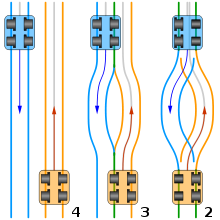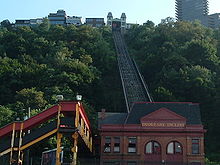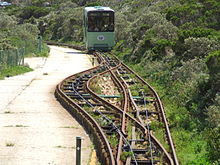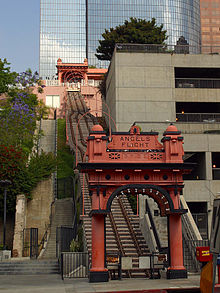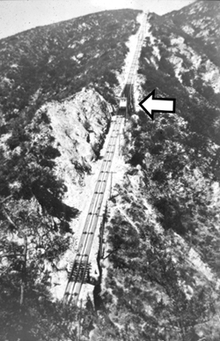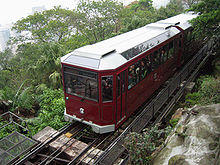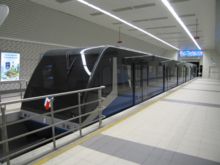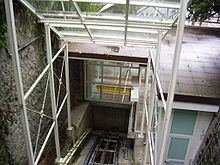- Funicular
-
A funicular, also known as an inclined plane or cliff railway, is a cable railway in which a cable attached to a pair of tram-like vehicles on rails moves them up and down a steep slope; the ascending and descending vehicles counterbalance each other.
Contents
Operation
The basic principle of funicular operation is that two cars are permanently attached to each other by a cable, which runs through a pulley at the top of the incline. Counterbalancing of the two cars, with one ascending and one descending, minimizes the energy needed to lift the ascending car. Winching is normally done by an electric drive which turns the pulley. Sheave wheels guide the cable to and from the drive mechanism and the incline cars.
A few funiculars have been built using water tanks under the floor of each car which are filled or emptied until just sufficient imbalance is achieved to allow movement. The movement is then controlled by a brakeman.
Gravity plane
Funiculars used in mines were sometimes unpowered gravity planes, also known as self-acting inclines or brake inclines. The weight of descending loaded wagons was used to pull the empty mine wagons.[1]
Bottom towrope
The cars can be attached to a second cable running through a pulley at the bottom of the incline in case the gravity force acting on the vehicles is too low to operate them on the slope. One of the pulleys must be designed as tensioning wheel to avoid slack in the ropes. In this case the winching can be done also at the lower end of the incline. This practice is used for funiculars with gradients below 6%, funiculars using sledges instead of cars or any other case where it is not ensured that the descending car is always able to pull out the cable from the pulley in the station on the top of the incline.[2]
Track layout
Early funiculars used two parallel straight tracks, with separate station platforms for each vehicle. The tracks are laid with sufficient space between them for the two cars to pass at the mid-point. The wheels of the cars are usually single-flanged, as on standard railway vehicles. Examples of this type of track layout are the Duquesne Incline in Pittsburgh, Pennsylvania, and most cliff railways in the UK.
Layouts which require less width have been developed, with only two or three rails for the most part of the slope and four rails only at the passing section.
The Swiss engineer Carl Roman Abt invented the method that allows cars to be used with a two-rail configuration: the outboard wheels have flanges on both sides, which keeps them aligned with the outer rail, thus holding each car in position, whereas the inboard wheels are unflanged and ride on top of the opposite rail, thereby easily crossing over the rails (and cable) at the passing track. This avoids the need for switches and crossings, since the cars have the flanged wheels on opposite sides and will automatically follow different tracks.
In layouts using three rails, the middle rail is shared by both cars. The three-rail layout is wider than the two-rail layout, but the passing section is simpler to build. If a rack for braking is used, that rack can be mounted higher in a three-rail layout, making it less sensitive to choking in snowy conditions.[2]
Some four-rail funiculars have the upper and lower sections interlaced and a single platform at each station. The Hill Train at Legoland, Windsor is an example of this configuration.
The track layout can also be changed during the renovation of a funicular, and often four-rail layouts have been rebuilt as two- or three-rail layouts; e.g. the Wellington Cable Car in New Zealand was rebuilt with two rails.
History of different track layouts
Until the end of the 1870s the four-rail parallel-track funicular was the normal configuration. Carl Roman Abt developed the Abt Switch allowing the two-rail layout, which was used for the first time in 1879 when the Giessbachbahn opened in Switzerland.[2] In the New World, the first funicular to use a two-rail layout was the Telegraph Hill Railroad in San Francisco, which was in operation from 1884 until 1886.[3] The Mount Lowe Railway in Altadena, California was the first mountain railway in the United States to use the three-track layout. Three- and two-rail layouts considerably reduced the space required for building a funicular, reducing grading costs on mountain slopes and property costs for urban funiculars. These layouts enabled a funicular boom in the latter 19th century.
Inclined lift
The inclined lift or inclined elevator is a special version of the funicular, since it has only one car carrying payload on the slope. The car is either winched up to the station on the top of the incline where the cable is collected on a winch drum, or the single car is balanced by a counterweight and operated the same way as a funicular with two cars. Many inclined lifts were constructed along the pressure lines of storage power plants for transporting building materials. Examples are the Gelmerbahn leading to the Gelmersee and the Funicolare Piora–Ritom leading to Lago Ritom, both in Switzerland. The steepest funicular in the world may be the incline lift Katoomba Scenic Railway in Australia[citation needed]. Modern versions resembling an elevator are used in public transport applications, such as at Cityplace Station in Dallas, Texas and Huntington Metro Station in Huntington, Virginia.
A mixture between an inclined lift and a funicular with two cars was the second Angels Flight in Los Angeles. The funicular closed in 1969 and was reinstalled in 1996 using separate cables for each car which were winched on separate winch drums in the station at the top. The winch drums were connected to the drive motor and the service brake by a gear train. The system failed because of gear train breakage, causing a fatal accident in 2001. The funicular was then closed until 2010.[4]
History
The oldest funicular is the Reisszug, a private line providing goods access to Hohensalzburg Castle at Salzburg in Austria. It was first documented in 1515 by Cardinal Matthäus Lang, who became Archbishop of Salzburg. The line originally used wooden rails and a hemp haulage rope, and was operated by human or animal power. Today steel rails, steel cables and an electric motor have taken over, but the line still follows the same route through the castle's fortifications.[5][6]
The first railway in England with wooden rails was probably made for James Clifford, lord of the manor of Broseley. He was working coal mines there by 1575 and had a waggonway delivering coal to barges on river Severn by 1606. This is after the first record of a railway in England, the Wollaton Wagonway, but seems to be earlier.[7]
In the 18th century funiculars were used to allow barge traffic on canals to ascend and descend steep hills. An early example were the three inclined planes on the Tyrone Canal in County Tyrone that were in use as early as 1777. They were used primarily in the early 19th century, especially during the height of the canal-building era in the 1830s in the United States. Such railways operated by allowing water in feeder canals at the top of the plane to drive a turbine, raising or lowering a canal barge along a steep slope.
Examples of hydropower inclined plane railroads in the United States included the Morris Canal in New Jersey connected the Delaware River with the Passaic River using 23 planes, as well as a series of locks along the gentler gradients. The Allegheny Portage Railroad, part of the Pennsylvania Main Line Canal, built in 1834 with ten planes as the first railroad across the Allegheny Mountains of Pennsylvania, was steam powered.[8]
Modern funicular railways operating in urban areas date from the 1860s. The first line of the Funiculars of Lyon (Funiculaires de Lyon) opened in 1862, followed by other lines in 1878, 1891 and 1900. The Budapest Castle Hill Funicular was built in 1868/9, with the first test run was on 23 October 1869. The oldest funicular railway operating in Britain dates from 1875 and is in Scarborough, North Yorkshire.[9]
One of the most famous funiculars was the Great Incline of the Mount Lowe Railway in Altadena, California, designed by Andrew Smith Hallidie of San Francisco cable car fame. The Mount Lowe Railway combined its funicular, raising passengers 2,800 feet (859 m) up the steep side of Mount Echo (elevation 3500 ft or 1067 m), with electric narrow-gauge trolley systems at each end (the Rubio Canyon line was standard-gauged after being acquired by Henry Huntington's Pacific Electric Railway). The Incline had three grade changes, the lower end at 62% easing to a 48% at the top, and the cars were designed to adjust to the grade changes for the comfort of their passengers. It had three rails to reduce the width of the formation and the materials required, though a complicated cable routing system was needed at the passing track.[10]
The eastern United States had several incline railways, most engineered by the Otis Elevator Company of Yonkers, NY (today a subsidiary of UTC in Connecticut). Perhaps the best example was the Mount Beacon Incline Railway in Beacon, NY, the steepest funicular Otis built in the northeast. It had an average gradient of 64+%, a maximum gradient of 74% and operated for over 75 years. It was destroyed by fire in 1983 and a not-for-profit society is currently working toward its restoration.
The funicular on Mount Vesuvius inspired the song Funiculì, Funiculà, composed in 1880. That funicular was wrecked repeatedly by volcanic eruptions and abandoned after the eruption of 1944.
World
Fløibanen is a funicular in Bergen, Norway which runs up the mountain of Fløyen. It is one of Bergen's major tourist attractions and one of Norway's most visited attractions.
Hong Kong's Peak Tram was one of the first funiculars in Asia, opened in 1888, maximum grade 48%, 1.4 km, and is still a daily transport for many people today.
Another funicular in Asia is located on Penang Hill, Penang, Malaysia. Located 6 km from George Town, Penang Hill (Bukit Bendera) is one of the most popular destinations in Penang. Penang Hill is actually a complex of hills and spurs and the highest point is Western Hill which is 830 meters (2730 ft) above sea level. The most convenient way up to Penang Hill is by means of a funicular railway which is in Air Itam. There is a tunnel which measures 258 feet (79 m) long and 10 feet (3.0 m) wide starting at steepness of 35 feet (11 m) high, which is the steepest tunnel in the world. The funicular train leaves every 30 minutes and can carry up to 80 passengers. One way tickets cost RM4. It takes about half an hour to the top. The funicular train does not go straight to the summit and will pass several small stations, where the locals will alight. There are also some small hotels and guesthouses on this stretch. During holiday seasons, the wait for this ride can take as long as 1 hour.
Valparaiso, Chile has 15 funiculars, the oldest dating from 1883. Some of them are inside the historic quarter which has been declared a World Heritage area by Unesco. Many are currently in disrepair and have been shut down by municipal authorities. There has been recent controversy regarding five of the elevators in the downtown area, where there have been protests about safety and operation. The Polanco Elevator, perhaps the most unusual, had been closed for repairs to the structure and recently re-entered service.[11]
The Scenic Railway at Katoomba Scenic World, Blue Mountains, Australia (which supports multiple tourist attractions such as the Skyway and Cableway), claims to be the world's steepest passenger carrying funicular railway, with a maximum incline of 52 degrees or 128% , with a total incline length of 310 Metres and a vertical lift of 206.5 M in a horizontal distance of 243.4. The railway is on the old mining track[12]
The Great Incline of the Mount Lowe Railway (above right) had multiple grades with cars that adjusted to the variations. The gentlest grade was 48%, the steepest 62%.
The Niesenbahn in the Swiss Kandertal is the longest continuous-cable funicular in Europe. In Lugano, a funicular connects the city centre with the above train station of SBB-CFF-FFS and Ferrovia Lugano-Ponte Tresa.
In Poland the most popular is the Gubałówka Hill Funicular, operated by Polish Cable Lines (Polskie Koleje Linowe, PKL).
Water-powered funiculars include the Lynton and Lynmouth Cliff Railway in North Devon, England; the CAT Funicular at the Centre for Alternative Technology in Gwynedd, Wales; the Nerobergbahn in Wiesbaden, Germany; and Bom Jesus funicular in Braga, Portugal (the oldest, still working, in the world).
The Great Orme Tramway is the only cablehauled tramway still operating on British public roads. It runs from Church Walks in Llandudno. It first opened on 31 July 1902 and runs on a daily basis from late March to late October taking visitors to the summit of The Great Orme, climbing a mile of track to the summit complex at a height of 679 ft (207)m. There are panoramic views of the Welsh mountains and as far as the Isle of Man, Blackpool and the Lake District. There is a exhibition of the history of this funicular tramway at the half-way station.[13]
Pittsburgh, Pennsylvania has two operational funiculars, called "inclines". The Monongahela Incline travels between the top of the Mount Washington hillside to Station Square at the base of the mountain along the Monongahela River. It serves as a tourist attraction and mass transit system. The Duquesne Incline connects Duquesne Heights with the lower elevations of Pittsburgh.
Naples, (Italy), has four funiculars. The Chiaia Funicular was built in 1889, followed within two years by the Funicolare of Montesanto (Montesanto Funicular), and after some years by Central Funicular and Mergellina. The most famous funicular in Naples was the Mount Vesuvius Funicular (1880–1944), the first railway track in the world built on an active volcano, and destroyed various times by Vesuvius eruptions. Partially modified to became a rack railway in its last section, it was destroyed by eruption in 1944. Its worldwide fame was because the Neapolitan song Funiculì Funiculà was dedicated to it.[14]
The Johnstown Inclined Plane (built 1890) in Johnstown, Pennsylvania in the United States claims to be the world's steepest vehicular inclined plane at 70.9%. In addition to passengers, it can carry one automobile in each direction. Chattanooga, Tennessee is home to the Lookout Mountain Incline Railway (built 1895) that travels from the base to the top of Lookout Mountain, and claims to be the steepest funicular in the world with a maximum grade of 72 percent.
In addition to the historic Angels Flight and Mount Lowe Railway, Southern California has two more recently constructed funicular railways. Six Flags Magic Mountain in Valencia, California has a funicular which takes guests up the Mountain from an area near the park entrance to a station near the Ninja coaster entrance. It was called "Funicular" for many years, introducing thousands of people to the word, but is now known as the "Orient Express" to fit in with the Far Eastern theme at the top of the Mountain. The Pacific Palms Resort[15] in the City of Industry, California, formerly the Industry Hills Sheraton Resort, utilizes a funicular to transport golfers and their carts. The 400-foot (120 m) line runs from the 9th Green of the "Ike" Course and 18th Green of the "Babe" Course to the St Andrews Station, a replica of a Scottish station that houses concessions and eating areas with spectacular views of the two hillside courses.[16] The railway was installed in 1979 as part of a 650-acre (2.6 km2) brownfield reclamation project that transformed a collection of hills containing a former refuse dump into a resort, convention and recreation center. The funicular was devised as a perfect solution for transporting golfers among the steep and dramatic terrain of the demanding and highly regarded golf courses. The railway is currently not in operation, but remains fully intact awaiting necessary maintenance until it can once again ferry golfers up the 33% grade overlooking the San Gabriel Valley and San Bernardino Mountains.
The Falls Incline Railway, originally the Horseshoe Falls Incline, at Niagara Falls, Canada gives access to hotels above the falls.
Private funiculars
Private funiculars on steep sections provide easier access from the street to a house than steep paths or steps. They are common in hilly cities like Wellington, New Zealand. They are often called cable cars or lifts (elevators), but have a small car for two to four people permanently attached to a cable from a winch. The car runs on an inclined pair of rails (beams) or a single rail at a low speed (0.3 to 1.0 metres/second). In Quebec City, Canada, the Old Quebec Funicular has been operating since 1879, connecting the Haute-Ville (Upper Town) to the Basse-Ville (Lower Town). Larger and faster models may give access to commercial buildings. Examples are USA, NZ, Legal requirements (NZ).
Smallest funicular
The smallest funicular in the world is the Fisherman's Walk Cliff Railway in Bournemouth, England, at a length of 128 feet (39 m).
The smallest funicular in Croatia is in Zagreb with a length of 66.0 m.[17]
The smallest funicular in Italy is the Ferata Gran Risa located in La Ila in South Tyrol, with a length of 66.7 m.[18]
The smallest funicular in Switzerland is located in Lucerne. It serves the guests of the 100 year-old hotel "Montana" and is of the same age as the hotel. One single cabin shuffles between the top station and the bottom station at the lake-promenade (length: 85 m).[19] The travel time for both directions is 60 seconds.
See also
- Public transport
- Rack railway (Cog railway)
- Reaction ferry
- Ski lift
- Slope car
References
- ^ Lake, R.D. (2009). "British Railways 1920–1970". http://www.britishrailways.info/images/ENGINEERING.htm. Retrieved 29 December 2010.
- ^ a b c Walter Hefti: Schienenseilbahnen in aller Welt. Schiefe Seilebenen, Standseilbahnen, Kabelbahnen. Birkhäuser, Basel 1975, ISBN 3-7643-0726-9 (German)
- ^ "Telegraph Hill Railroad". The Cable Car Home Page – Cable Car Lines in San Francisco. Joe Thompson. 1 July 2009. http://www.cable-car-guy.com/html/ccsf.html#thrr. Retrieved 20 September 2009. "The Telegraph Hill Railroad was not a cable car line ...; it was a funicular railway"
- ^ Wall Street Journal: p. A6. 16 March 2010.
- ^ "Der Reiszug – Part 1 – Presentation". Funimag. http://www.funimag.com/funimag10/RESZUG01.HTM. Retrieved 2009-04-22.
- ^ Kriechbaum, Reinhard (2004-05-15). "Die große Reise auf den Berg" (in German). der Tagespost. http://www.die-tagespost.de/Archiv/titel_anzeige.asp?ID=8916. Retrieved 2009-04-22.
- ^ Peter King, 'The first Shropshire Railways' in G. Boyes (ed.), Early Railways 4: Papers from the 4th International Early Railways Conference 2008 (Six Martlets, Sudbury, 2010), 81–4.
- ^ "Allegheny Portage Railroad Reading 1: Riding on the inclined plane". http://www.nps.gov/history/nr/twhp/wwwlps/lessons/23allegheny/23facts1.htm. Retrieved 2009-02-20.
- ^ "Blunder traps eight on cliff lift". BBC News. 2009-04-24. http://news.bbc.co.uk/1/hi/england/north_yorkshire/8017535.stm. Retrieved 2010-04-02.
- ^ The railway opened on 4 July 1893, and by 1902 it was operated by Pacific Electric Railway. It ran around the edges of the foothills to Ye Alpine Tavern, only 1,100 ft (335 m) from the Mount Lowe summit. In 1936 the last of the standing buildings, the Tavern, burned down, and the railway was abandoned after the Los Angeles deluge of March 1938.
- ^ LOGIN.CL reports on bad state of repair of elevators |http://www.login.cl/index.php?action=show&type=news&id=2220
- ^ "Top five funicular railways". Sydney Morning Herald. http://www.smh.com.au/news/take-five/top-five-funicular-railways/2005/10/29/1130400400382.html.
- ^ For more information on The Great Orme Tramway go to www.greatormetramway.co.uk
- ^ http://www.portanapoli.com/Ita/Cultura/canzone-napoletana/funiculi.html
- ^ "Industry Hills Golf Club". Ihgolfclub.com. http://www.ihgolfclub.com/. Retrieved 2010-12-17.
- ^ "The Cable Car Home Page – Los Angeles Area Funiculars". Cable-car-guy.com. http://www.cable-car-guy.com/html/cclafun.html#ihills. Retrieved 2010-12-17.
- ^ "Funimag". http://www.funimag.com/funimag16/Zagreb04.htm.
- ^ "Ferata GranRisa". http://www.lift-world.info/de/lifts/3261/datas.htm. Retrieved 25. Jänner 2011.
- ^ HOMM interactive – Luzern ::: Strategien sichtbar machen. "in the last fourth of the movie". Hotel-montana.ch. http://www.hotel-montana.ch/index.php?page=108. Retrieved 2010-12-17.
External links
- New York Times article on Pennsylvania funiculars
- Mount Beacon Incline Railway Restoration Society
- Funimag, the first web magazine about funiculars
- Urban Mountain Railways and People Movers
- Video of Lynton and Lynmouth Cliff Railway in action
- The Vesuvian Funicular, Italy
Ski lifts Aerial lifts 
Surface lifts Cable railways FunicularCategories:- Funicular railways
- Rail transport
- Vertical transport devices
- Alternatives to conventional railways
Wikimedia Foundation. 2010.


